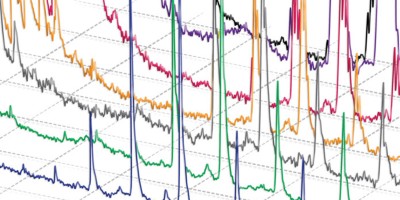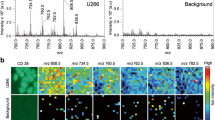Abstract
This protocol measures externalization of aminophospholipids (APLs) to the outside of the plasma membrane using mass spectrometry (MS). APL externalization occurs in numerous events, and it is relevant for transplant medicine, immunity and cancer. In this protocol, externalized APLs are chemically modified by using a cell-impermeable reagent (sulfo-NHS-biotin), and then they are isolated via a liquid:liquid extraction and quantified by reverse-phase liquid chromatography tandem MS (LC-MS/MS) against in-house-generated standards. This protocol describes a complementary method to existing assays that are not quantitative (e.g., annexin V flow cytometry), and it is applicable to the study of membrane reorganization in all cell types during apoptosis (e.g., during development, cancer, psychiatric disorders and other conditions, aging, vesiculation and cell division). The protocol takes ∼2–4 d, including the generation of standards.






Similar content being viewed by others
References
Daleke, D.L. Phospholipid flippases. J. Biol. Chem. 282, 821–825 (2007).
Ravichandran, K.S. Find-me and eat-me signals in apoptotic cell clearance: progress and conundrums. J. Exp. Med. 207, 1807–1817 (2010).
Heemskerk, J.W., Bevers, E.M. & Lindhout, T. Platelet activation and blood coagulation. Thromb. Haemost. 88, 186–193 (2002).
Clark, S.R. et al. Characterization of platelet aminophospholipid externalization reveals fatty acids as molecular determinants that regulate coagulation. Proc. Natl. Acad. Sci. USA 110, 5875–5880 (2013).
Shi, J. & Gilbert, G.E. Lactadherin inhibits enzyme complexes of blood coagulation by competing for phospholipid-binding sites. Blood 101, 2628–2636 (2003).
Otzen, D.E., Blans, K., Wang, H., Gilbert, G.E. & Rasmussen, J.T. Lactadherin binds to phosphatidylserine-containing vesicles in a two-step mechanism sensitive to vesicle size and composition. Biochim. Biophys. Acta 1818, 1019–1027 (2012).
Meers, P. & Mealy, T. Phospholipid determinants for annexin V binding sites and the role of tryptophan 187. Biochemistry 33, 5829–5837 (1994).
Koopman, G. et al. Annexin V for flow cytometric detection of phosphatidylserine expression on B cells undergoing apoptosis. Blood 84, 1415–1420 (1994).
Gao, C. et al. Procoagulant activity of erythrocytes and platelets through phosphatidylserine exposure and microparticles release in patients with nephrotic syndrome. Thromb. Haemost. 107, 681–689 (2012).
Daleke, D.L. Regulation of transbilayer plasma membrane phospholipid asymmetry. J. Lipid Res. 44, 233–242 (2003).
Andree, H.A. et al. Binding of vascular anticoagulant α (VAC α) to planar phospholipid bilayers. J. Biol. Chem. 265, 4923–4928 (1990).
Hullin, F., Bossant, M.J. & Salem, N. Jr. Aminophospholipid molecular species asymmetry in the human erythrocyte plasma membrane. Biochim. Biophys. Acta 1061, 15–25 (1991).
Schick, P.K., Kurica, K.B. & Chacko, G.K. Location of phosphatidylethanolamine and phosphatidylserine in the human platelet plasma membrane. Clin. Invest. 57, 1221–1226 (1976).
Rothman, J.E. & Kennedy, E.P. Rapid transmembrane movement of newly synthesized phospholipids during membrane assembly. Proc. Natl. Acad. Sci. USA 74, 1821–1825 (1977).
Hurley, W.L. & Finkelstein, E. Identification of leukocyte surface proteins. Methods Enzymol. 184, 433–1825 (1990).
Bligh, E.G. & Dyer, W.J. A rapid method of total lipid extraction and purification. Can. J. Biochem. Physiol. 37, 911–917 (1959).
Acknowledgements
The studies were funded by the Wellcome Trust (V.B.O., V.J.H., P.W.C.). C.P.T. is a Marie Curie International Outgoing Fellow.
Author information
Authors and Affiliations
Contributions
C.P.T., S.R.C., V.J.H. and M.A. conducted the experiments; V.B.O. and C.P.T. wrote the paper; and P.W.C. edited the paper. V.B.O., S.R.C., C.P.T. and P.W.C. designed the protocols.
Corresponding author
Ethics declarations
Competing interests
The authors declare no competing financial interests.
Rights and permissions
About this article
Cite this article
Thomas, C., Clark, S., Hammond, V. et al. Identification and quantification of aminophospholipid molecular species on the surface of apoptotic and activated cells. Nat Protoc 9, 51–63 (2014). https://doi.org/10.1038/nprot.2013.163
Published:
Issue Date:
DOI: https://doi.org/10.1038/nprot.2013.163
- Springer Nature Limited
This article is cited by
-
Critical shifts in lipid metabolism promote megakaryocyte differentiation and proplatelet formation
Nature Cardiovascular Research (2023)
-
Targeting bacteria via iminoboronate chemistry of amine-presenting lipids
Nature Communications (2015)





